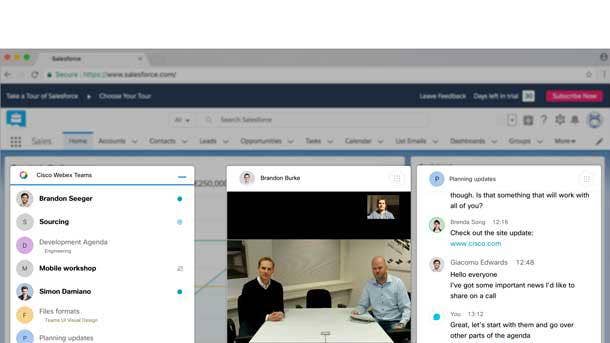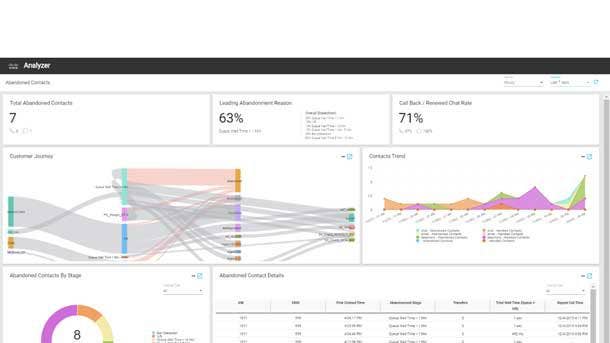Cisco’s Jeetu Patel On The Dreaded ‘Second-Class’ Meeting Citizens, Playing Nice With The Competition, And Webex’s Future
Cisco’s collaboration and security leader talks about the 400 new Webex developments in the last six months, remote working challenges, “built-in, not bolted-on” security, and offered a sneak peak into Webex’s roadmap.

Equal-Opportunity Collaboration
Jeetu Patel, Cisco’s senior vice president and general manager, security and applications group -- which houses the Cisco Webex division -- has been at the helm since June. It’s safe to say that his first eight months in the job have been equal parts uncertainty and nonstop innovation.
Patel made the leap to Cisco in the midst of a global pandemic, which had millions of new and existing users all over the globe flocking to the popular Webex platform to help them keep communications and collaboration flowing so their businesses could keep moving, even if every employee was now working from home.
Cisco’s Webex division quickly got to work to scale the platform to accommodate new users, and after the initial influx of demand calmed, Patel’s unit got to work speeding up research and development of Webex (a whopping 400 new Webex capabilities have been launched since September).
One product of that work is the recently launched real-time language translation feature for Webex, which the tech giant said will foster a more “inclusive” environment for collaboration.
The volume of innovation, said Patel, has never been higher. And the most exciting part? This global collaboration “experiment” might be a great leveler. That’s because regardless of geography, language preference and socioeconomic level, collaboration platforms have proved that people can now be hired and work from anywhere, Patel said.
“Opportunity is not equally accessible and is unequally distributed, even though human potential is not,” Patel said.
But at the same time, the unified communications and collaboration market still has some work to do. For example, many tools are making for great planned communications, also known as scheduled meetings and calls. However, more spontaneous communications, like hallway chatter and random break room conversations, haven’t been successfully addressed yet, which will go a long way in building more inclusive environments in which remote employees aren’t treated like “second-class citizens,” Patel said.
In a candid conversation with reporters, Patel this month talked about Webex development, and new features, remote working challenges, security concerns, and provided a sneak peak into Webex’s future roadmap and integration plans.
What follows are excerpts from the Q&A.

What has been greatest challenge for the collaboration market over the past year?
The possibilities of all the things that could happen. The first phase of this was: “It seems like there’s a lot of customers that we need to make sure stay up and running,” so last year at this time, the focus was [keeping] the system up, scale the data center, make sure the businesses are running. That was number one. Step two; there were a lot of small little areas that were starting to [become] annoyances to people because [users] didn’t know how to use the systems sometimes, and working from home, they didn’t have IT support, so you had to make sure it was easy to use and there were no kinks in the products.
Now, it’s [about] what the possibilities are for innovation because if you fast forward five years, hopefully we aren’t just looking at each other in these boxes on the screen -- that’s not the way we are going to communicate. We are going to be more immersive in the way we communicate. So, there’s going to be a fair amount of innovation at work so this [experience] truly gets to 10x better than in person. How are [we doing that]? You can record a conversation, you can share convos with someone, you can transcribe it for people speaking different languages, and you can make features that allow introverts to have an equal voice in the room … those kinds of things are very unique. The biggest challenge though, is getting those technologies to be more functional, and capabilities-wise, very rich. how do you make sure that [you build technologies] for people that are not as technologically adept and make it as simple as possible. The challenge is, how do you keep simplifying? And never be satisfied that it’s simple enough. How many clicks does it take to join a Webex, and can we shave off one more click? Those are all things we’re trying to do.

What are the top concerns enterprises have about back-to-work strategies?
We believe the future will definitely be hybrid. Sometimes people will work from home, sometimes from the office. When you’re working from home, we want to make those experiences 10x better than in-person interactions. In the office, one of the big areas we found in our research was that people were not feeling safe to return. So, how do you make sure you’re maintaining social distancing guidelines and people are maintaining a certain level of hygiene and aren’t getting lax [and] potentially spreading COVID around more. So, one of the areas we are focused on is how to make sure you’re obviously working well when you’re remote, but what do you do when you are back in the office so that you have a safe return to the workplace?
The one thing that is going to be different going forward is 100 percent of people won’t be in the office at the same time -- that we think has fundamentally shifted. But the people that have been at home, historically, used to be second-class citizens in meetings. What we need to do is when there’s a group of people together and some people are not in the room, [we have to] make sure they have a level playing field so everyone can have an equal voice in the meeting. We’re thinking about; don’t drown out the introverts and make sure people can debate ideas and the people in the room don’t suck up all the energy in the room. Those are important social constructs that will make for a more inclusive world.

What is Cisco’s integration strategy for Webex?
One of the things that has been the beauty of the [Software-as-a-Service] SaaS ecosystem compared to the previous generation of software on-prem, is that previously, people bought everything from one vendor. Why? Because it all worked well together. Now, when you think about the SaaS ecosystem, you have restful APIs, which are basically APIs you can access through a URL. Now, the expectation is that everything works with everything. Our goal is to make sure we integrate with any application that a customer has invested in. Frankly, I don’t care if it’s a competitor, we will integrate with them. The competitor may not allow us to, in which case, we will let the market know what is happening, but we want to integrate with everyone in the market.
For example, we bought Slido [and] one of the things we’ll continue to do is integrate with [Microsoft] Teams and Zoom because we want to make sure [those platforms] get the benefit of that as well. So, we’ll make sure to keep cross-collaborating and integrating. Our goal is to make sure thousands of companies can have bi-directional integration into Webex. That means that if you’re in a Webex meeting and you want to make sure this capability from this third-party company can be incorporated in, we’ll be able to provide a framework … We’ve done that now with Box, Dropbox, [and] ServiceNow. We also have a capability -- which is unique, our competitors don’t do this -- where we integrate our product as an API into other people’s products. We don’t care if a person uses our [user interface] UI or someone else’s UI. If a customer has invested in a technology and us, it’s our job to make sure the two of those technologies work seamlessly well together.

How is Cisco making Webex more secure?
The difference is actually in the philosophy of the company. We fundamentally believe privacy is a basic human right. So, when we think about it that way, the way in which you build the products are with that in mind. You build the products from the ground up with that as a core operating principle in mind. Conversely, others may have started from a very different vantage point. They may have started from the consumer vantage point, and then privacy becomes an afterthought. It’s not actually about, “do I have this or that feature?” It’s what’s the core value of the organization. If the core value doesn’t have privacy in the fabric, it’s very hard to instill that after the fact.
Security and compliance are areas where we are going to be fanatically focused -- it’s an area that is built-in, not bolted on. An example is later this year, we’ll have this capability available called Ethical Walls. [An example] of this capability is let’s say I’m a consulting firm working with Coca Cola and Pepsi. I don’t want those teams talking to each other because there’s a competitive dynamic and you want to keep them apart. The system will be able to determine which teams are prohibited from communicating with each other because of ethical walls.
We’re investing very aggressively [in security] and I’m actually lucky enough that I run the collaboration and security businesses at Cisco. Those two businesses have a lot in common.

What will the future of Webex look like?
One of the things we are doing is making sure video layouts will change quite a bit over the course of the next few months to allow for really flexible layouts. If I’m in a budget meeting, I really want to see how my CFO or CEO is thinking. I need to make sure [they are] front and center in my view and everyone else can be in the background. You’ll be able to do that [by] drag and drop in the next few months.
The other big area where there will be innovation is … I think there is a lot of possibility around 3D, augmented and virtual reality that can come into play. We’re not ready to talk about that yet but know that’s a general direction we’ll be doing a lot of stuff in.
Then, the amount of insight and analytics we have in the system will get infinitely better as you [see] the insights we give to people and teams working together will get better, while maintaining privacy as the baseline. We’ll be doing a huge amount of investing in AI and a lot more hardware and software integration. We’ve done 400 [new Webex] features from September to February, and just know that we aren’t slowing down.